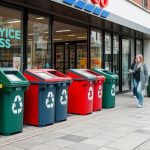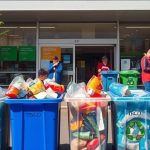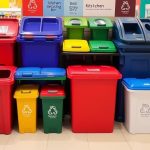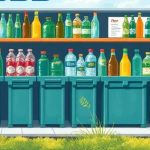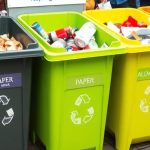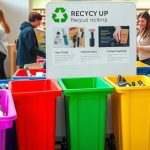Tesco Toy Recycling Truck: Making Playtime Sustainable
The Tesco toy recycling truck offers a brilliant solution for sustainable toys. It tackles toy waste management in the UK, making eco-friendly playtime a reality. This innovative initiative is changing how we think about children’s toys and the environment.
Parents are looking for toys that entertain and help the planet. Tesco’s recycling truck gives families a practical way to reduce toy waste. It’s a big step towards more responsible toy consumption.
These sustainable toys meet strict safety standards set by the Toys (Safety) Regulations 2011. Tesco goes beyond fun, teaching kids about recycling through hands-on methods. This approach makes learning about the environment engaging for children.
Toy disposal is tricky in the UK. Many recycling centres won’t take toys because they’re made of different materials. Tesco’s truck solves this problem for eco-minded families.
With this new recycling option, Tesco helps people make greener choices. It turns eco-friendly playtime into something real and easy for UK families. This initiative is a game-changer for sustainable toy use.
Understanding Sustainable Toy Manufacturing
The global toy industry faces a critical environmental challenge. Toy production uses 40 tons of plastic per $1 million in revenue. Nearly 80% of toys end up in landfills, incinerators, or oceans.
Discarded toys contribute 3.2 billion kilograms of e-waste annually. This is 77 times more than mobile phone waste. These facts highlight the need for eco-friendly and recycled toy materials.
Environmental Impact of Traditional Toy Production
- High plastic consumption in toy manufacturing
- Significant waste generation
- Long-term ecological consequences
- Resource-intensive production processes
Sustainable Materials in Modern Toy Making
Toy makers are shifting towards greener options. Innovative materials like bioplastics, recycled plastics, and sustainable wood are changing the industry. These materials reduce harm to nature while keeping toys safe and high-quality.
| Material Type | Environmental Benefit | Recyclability |
|---|---|---|
| Bioplastics | Reduced Carbon Footprint | High |
| Recycled Plastics | Waste Reduction | Moderate |
| Sustainably Sourced Wood | Forest Conservation | High |
The Role of Recycled Materials in Toy Manufacturing
“Recycling transforms waste into opportunity, creating a circular economy that benefits both manufacturers and the environment.”
Recycled materials are vital in sustainable toy making. They turn plastic waste into new toy parts, cutting down on harm to nature. The process changes old plastics into pellets for making eco-friendly toys.
Tesco Toy Recycling Truck: Features and Benefits
Tesco’s recycling truck toy blends entertainment and education for children. This unique toy inspires young minds to think about environmental responsibility. It combines eco-friendly design with engaging play experiences.
Eco-friendly Design Elements
The Tesco recycling truck showcases a sustainable approach to toy manufacturing. It’s crafted from recycled plastics, demonstrating a commitment to eco-friendly design.
Key design elements include:
- Made from 100% recycled materials
- Minimalist packaging to reduce waste
- Non-toxic, child-safe paint
- Compact design for easy storage
Educational Value for Children
This recycling truck model offers significant educational benefits. Children learn about waste management and recycling through interactive play. They develop an understanding of critical environmental concepts.
Play is the highest form of learning for children, and this toy transforms complex environmental concepts into accessible experiences.
Durability and Safety Standards
Tesco prioritises child safety with strict manufacturing standards. The toy complies with UK safety regulations. Parents can trust its quality and longevity.
| Safety Feature | Specification |
|---|---|
| Material Strength | Impact-resistant plastic |
| Age Recommendation | 3-7 years |
| Certification | UKCA Marked |
The Tesco recycling truck is a clever children’s toy. It combines play, education, and environmental awareness in one engaging product.
The Impact of Toy Recycling on the Environment
The toy industry poses a significant environmental challenge. Nearly 80% of toys end up in landfills, incinerators, or oceans. This contributes to about 6% of landfill plastics.
Toys can take hundreds to thousands of years to decompose. This long-lasting impact makes toy recycling crucial for our planet’s health.
Sustainable play offers vital environmental benefits. The toy industry uses 40 tons of plastic for every £1 million in revenue. It’s one of the most plastic-intensive industries worldwide.
Alarmingly, 90% of toys are made from petroleum-based materials. This contributes significantly to carbon emissions, harming our environment.
*Recycling is not just about waste management, but about preserving our planet for future generations.*
Key Environmental Insights
- E-waste from toys reaches 3.2 billion kilograms annually
- Up to 90% of toy materials can potentially be recycled
- Microplastics from toy breakdown contaminate ecosystems
| Environmental Metric | Impact |
|---|---|
| Toy Landfill Contribution | 80% of toys end up in waste streams |
| Recycling Potential | 90% of materials can be repurposed |
| Carbon Emission Equivalent | Deforestation of 1 billion trees |
Sustainable play practices can greatly reduce environmental damage. Children’s involvement in recycling boosts their understanding of sustainability by 70%. This creates a shift towards eco-conscious behaviour in future generations.
Proper Disposal and Recycling Methods for Children’s Toys
Responsible toy disposal is vital for our environment. UK households create massive toy waste. Nearly 80% of toys end up in landfills or oceans.
Recycling toys needs careful thought about materials and local rules. Toy makeup often makes recycling tricky.
Battery-Powered Toy Recycling Guidelines
Battery-powered toy recycling needs special care. UK supermarkets like Tesco offer battery recycling points. Here are key guidelines:
- Remove batteries from toys before recycling
- Never dispose of toy car batteries in regular rubbish
- Take batteries to designated recycling points
- Check local council regulations for electronic toy disposal
Plastic Toy Recycling Process
Plastic toy recycling varies by material type. Many councils accept clean, hard plastic toys in household recycling. The process typically involves:
- Sorting toys by plastic type
- Cleaning and preparing materials
- Shredding plastic components
- Melting and reforming into new products
Finding Local Recycling Facilities
Finding proper recycling facilities takes some research. Here are some options:
- Local council recycling centres
- Charity shops accepting complete toys
- Retailer take-back schemes
- Specialised toy recycling programs
Tip: Always check local guidelines, as toy recycling options can vary significantly between regions.
Recycling toys isn’t just about waste management—it’s about teaching children environmental responsibility.
| Toy Type | Recycling Method | Local Availability |
|---|---|---|
| Plastic Toys | Household Recycling | High |
| Electronic Toys | WEEE Collection Points | Medium |
| Soft Toys | Textile Recycling | Low |
| Wooden Toys | Composting/Special Disposal | Variable |
Conclusion
Tesco’s recycling initiative tackles environmental issues in the toy industry. Nearly 80% of toys end up in landfills, making up 6% of plastic waste. Sustainable playtime is now a necessity, not just a choice.
Eco-friendly toy choices are crucial for reducing environmental impact. Discarded toys contribute 3.2 billion kilograms of e-waste annually. Parents can make a difference by supporting recycling initiatives and donation programmes.
Sustainable practices can transform the toy industry’s environmental footprint. These actions can reduce greenhouse gas emissions and protect natural resources. Our choices today will shape a greener future for children’s playtime.
Sustainable toy management needs collaboration between retailers, manufacturers, and consumers. Every step, from buying responsibly to recycling properly, helps solve environmental problems. Together, we can create a more sustainable toy industry.
FAQ
What makes the Tesco toy recycling truck environmentally friendly?
The Tesco toy recycling truck uses recycled plastics and has sustainable packaging. It teaches children about environmental responsibility through play. The design aims to reduce waste and encourage eco-friendly playtime.
How can this toy help children understand recycling?
This toy shows recycling processes through interactive play. Children can pretend to collect and sort waste. It’s a hands-on tool that teaches environmental awareness in a fun way.
Are recycled plastic toys as durable as traditional toys?
Yes, recycled plastic toys can be just as durable as conventional ones. Tesco tests the toy recycling truck thoroughly. This ensures it’s safe, sturdy, and long-lasting.
What types of materials are used in sustainable toy manufacturing?
Sustainable toys use materials like bioplastics and recycled plastics. They also use responsibly sourced wood. These eco-friendly options reduce carbon footprint and waste.
How can parents properly recycle old children’s toys?
Parents should check local recycling rules first. Then, separate different materials and remove batteries from electronic toys. They can use retailer take-back schemes or community recycling centres.
What environmental benefits come from recycling toys?
Toy recycling helps reduce landfill waste and save natural resources. It also lowers carbon emissions. Recycling promotes a circular economy by turning old materials into new products.
Is the Tesco toy recycling truck suitable for all age groups?
The toy is designed for children aged 3-7 years. It offers age-appropriate learning while ensuring safety. The realistic design and interactive features keep kids engaged.
How does Tesco contribute to sustainable toy production?
Tesco uses recycled materials in toy manufacturing. They create educational products that teach about the environment. The company also supports responsible production practices.

